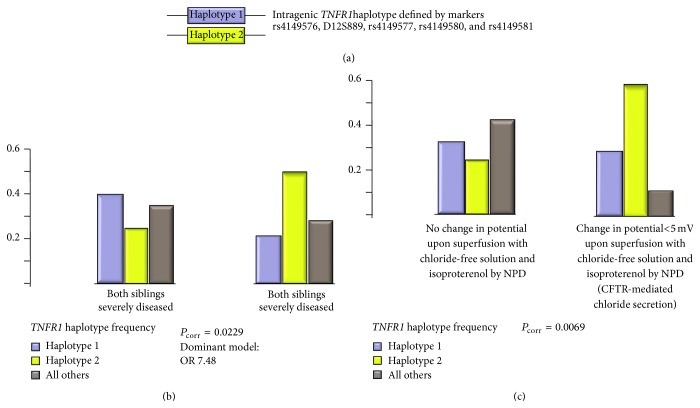Figure 1.
Association of TNFR1 variants with CF disease severity and manifestation of CFTR-mediated residual chloride secretion in respiratory tissue among F508del-CFTR homozygous CF patients. (a) Definition of TNFR1 variants. Two contrasting haplotypes, designated haplotype 1 and haplotype 2 within this figure, were described by typing the five markers rs4149576, D12S889, rs4149577, rs4149580, and rs4149581 among 101 families with a total of 171 F508del-CFTR homozygous CF patients [13]. Haplotypes were reconstructed using the software FAMHAP [14]. Association was judged by case-reference association whereby cases and references were defined based on the disease severity of the siblings (b) or the manifestation of a change in potential upon superfusion of the nasal epithelium with chloride-free solution and isoproterenol (c). All P values reported within this figure were calculated by FAMHAP and are corrected for sibling dependence and testing of multiple markers [14]. Please note that the case and control subpopulations compared within (b) and (c) were defined independently and were nonoverlapping (for details, please see [13]). Please also note that haplotype 2, depicted in green within this figure, is overrepresented among sib pairs with mild CF disease and among patients who display CFTR-mediated residual chloride secretion by NPD. As a causal interpretation, this might reflect the crosstalk between the cytokine pathway and the ion secretory properties of the epithelium [15–25], indicating that the mild TNFR1 haplotype 2 is more susceptible to translating the action of the host defense modifier gene TNFR1 into CFTR-mediated residual function. Alternatively, as CFTR-mediated residual chloride secretion causes a mild disease phenotype, the observed TNFR1 association with the manifestation of the basic defect in NPD might reflect an overrepresentation of mild modifier alleles among patients with residual CFTR-mediated chloride secretion, which is equivalent to a replication study with confirmatory outcome.

